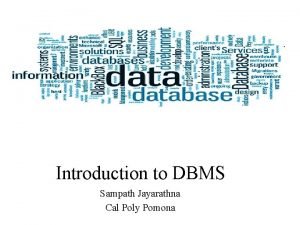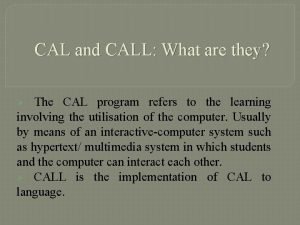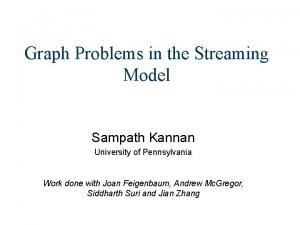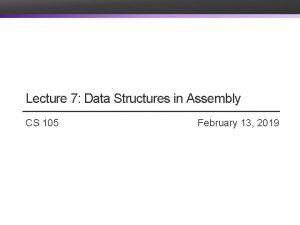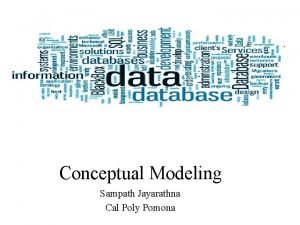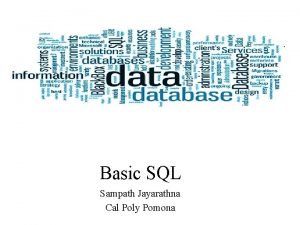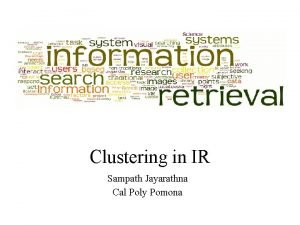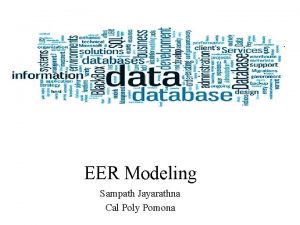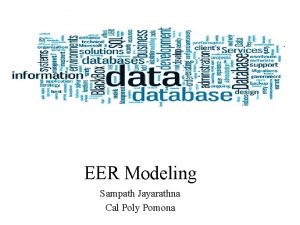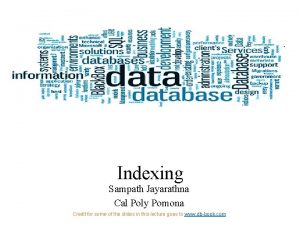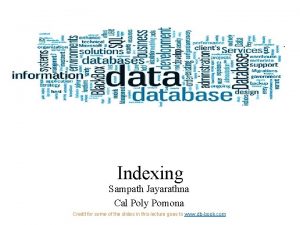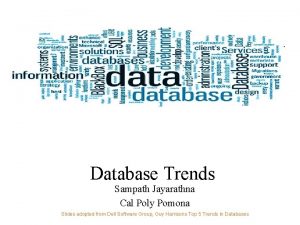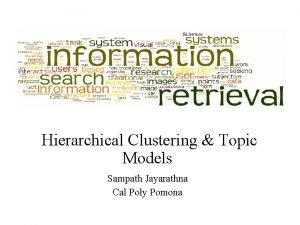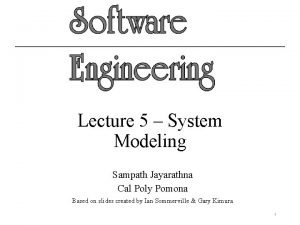Normalization Sampath Jayarathna Cal Poly Pomona Data normalization


























- Slides: 26

Normalization Sampath Jayarathna Cal Poly Pomona

Data normalization • Normalization is a formal process for deciding which attributes should be grouped together in a relation • Normalization is a process that “improves” a database design by generating relations that are of higher normal forms. • The objective of normalization: “to create relations where every dependency is on the key, the whole key, and nothing but the key”.

Semantics of the Relational Attributes must be clear • GUIDELINE 1: Informally, each tuple in a relation should represent one entity or relationship instance. (Applies to individual relations and their attributes). • Attributes of different entities (EMPLOYEEs, DEPARTMENTs, PROJECTs) should not be mixed in the same relation • Only foreign keys should be used to refer to other entities • Entity and relationship attributes should be kept apart as much as possible. • Bottom Line: Design a schema that can be explained easily relation by relation. The semantics of attributes should be easy to interpret.

A simplified COMPANY relational database schema

Redundant Information in Tuples and Update Anomalies • Information is stored redundantly • Wastes storage • Causes problems with update anomalies • Insertion anomalies • Deletion anomalies • Modification anomalies • Consider the relation: • EMP_PROJ(Emp#, Proj#, Ename, Pname, No_hours) • Update Anomaly: • Changing the name of project number P 1 from “Billing” to “Customer. Accounting” may cause this update to be made for all 100 employees working on project P 1.

EXAMPLE OF AN INSERT ANOMALY • Consider the relation: • EMP_PROJ(Emp#, Proj#, Ename, Pname, No_hours) • Insert Anomaly: • Cannot insert a project unless an employee is assigned to it. • Conversely • Cannot insert an employee unless an he/she is assigned to a project.

EXAMPLE OF A DELETE ANOMALY • Consider the relation: • EMP_PROJ(Emp#, Proj#, Ename, Pname, No_hours) • Delete Anomaly: • When a project is deleted, it will result in deleting all the employees who work on that project. • Alternately, if an employee is the sole employee on a project, deleting that employee would result in deleting the corresponding project.

Two relation schemas suffering from update anomalies Figure 14. 3 Two relation schemas suffering from update anomalies. (a) EMP_DEPT and (b) EMP_PROJ.

Normalization of Relations • Normalization: • The process of decomposing unsatisfactory "bad" relations by breaking up their attributes into smaller relations • Normal form: • Condition using keys and FDs of a relation to certify whether a relation schema is in a particular normal form

Data normalization • 2 NF is better than 1 NF; 3 NF is better than 2 NF • For most business database design purposes, 3 NF is as high as we need to go in normalization process • Highest level of normalization is not always most desirable

Functional dependencies and keys • Functional dependency: the value of one attribute (the determinant) determines the value of another attribute • A -> B, for every valid instance of A, that value of A uniquely determines the value of B • Candidate key: an attribute or combination of attributes that uniquely identifies an instance • Uniqueness: each non-key field is functionally dependent on every candidate key • Non-redundancy

Examples of FD constraints (1) • Social security number determines employee name • SSN ENAME • Project number determines project name and location • PNUMBER {PNAME, PLOCATION} • Employee ssn and project number determines the hours per week that the employee works on the project • {SSN, PNUMBER} HOURS

Conversion to First Normal Form (continued)

First normal form • No multi-valued attributes. • Every attribute value is atomic. • The following in not in 1 NF Emp. Num 123 333 679 Emp. Phone 233 -9876 233 -1231 Emp. Degrees BA, BSc, Ph. D BSc, MSc

Second normal form • 1 NF and every non-key attribute is fully functionally dependent on the primary key. • Every non-key attribute must be defined by the entire key, not by only part of the key. • No partial functional dependencies.

Conversion to Second Normal Form

Normalizing into 2 NF and 3 NF Figure 14. 11 Normalizing into 2 NF and 3 NF. (a) Normalizing EMP_PROJ into 2 NF relations. (b) Normalizing EMP_DEPT into 3 NF relations.

Third normal form • 2 NF and no transitive dependencies (functional dependency between non-key attributes. )

Removing a transitive dependency

Relations in 3 NF

The Boyce-Codd Normal Form (BCNF) • Every determinant in table is a candidate key • Has same characteristics as primary key, but for some reason, not chosen to be primary key • When table contains only one candidate key, the 3 NF and the BCNF are equivalent • BCNF can be violated only when table contains more than one candidate key

The Boyce-Codd Normal Form (BCNF) (continued) • Most designers consider the BCNF as special case of 3 NF • Table is in 3 NF when it is in 2 NF and there are no transitive dependencies • Table can be in 3 NF and fails to meet BCNF • No partial dependencies, nor does it contain transitive dependencies • A nonkey attribute is the determinant of a key attribute

The Boyce-Codd Normal Form (BCNF) (continued)

The Boyce-Codd Normal Form (BCNF) (continued)

Normal Forms Defined Informally • 1 st normal form • All attributes depend on the key • 2 nd normal form • All attributes depend on the whole key • 3 rd normal form • All attributes depend on nothing but the key 25

Class Activity 8 • Given the schema R= (A, B, C, D, E) and the following dependencies: A→B A→C D→E Assuming only the above dependencies, find a key for R. Decompose R into a schema in 3 NF. 26
 Cal poly pomona software engineering
Cal poly pomona software engineering Cal poly pomona registrar's office
Cal poly pomona registrar's office Intern
Intern Is cal poly pomona quarter or semester
Is cal poly pomona quarter or semester Cal poly databases
Cal poly databases Cal poly pomona finance
Cal poly pomona finance Processing
Processing Beth chance cal poly
Beth chance cal poly Cal poly bike lockers
Cal poly bike lockers Cal poly slo portal
Cal poly slo portal Cal poly slo construction management
Cal poly slo construction management Cal poly bike lockers
Cal poly bike lockers Frank owen cal poly
Frank owen cal poly Quantitative analysis cal poly
Quantitative analysis cal poly Evd deloitte
Evd deloitte Beth chance
Beth chance Cal poly database
Cal poly database Cal poly academic personnel
Cal poly academic personnel Cal poly triathlon
Cal poly triathlon Cal and cal
Cal and cal Sampath kannan
Sampath kannan P sampath
P sampath Sanjay sampath
Sanjay sampath Srinidhi sampath kumar
Srinidhi sampath kumar Cs105 pomona
Cs105 pomona Pomona pd news
Pomona pd news Pomona workday
Pomona workday




